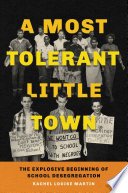Menu
- About
- Categories
Categories

A Most Tolerant Little Town: The Explosive Beginning of School Desegregation

Top of the pile
78
/100
I Index Overall Rating

Readers
Critics
Scholars
N/A
Author:
Rachel Louise Martin
Publisher:
Simon & Schuster
Date:
June 13, 2023
An intimate portrait of a small town living through tumultuous times. The story of a forgotten piece of civil rights historyâabout the first school to attempt court-ordered desegregation in the wake of Brown v. Board.
What The Reviewers Say
Samuel G. Freedman,
The New York Times Book Review
The New York Times Book Review
Martin’s book provided the disturbing, destabilizing experience of being thrust back into a period of intense racial hatred as if it were happening in real time. It is one thing to recall famous photographs of police dogs set loose on child marchers during the civil rights movement, or of lynch mobs picnicking around a still-hanging corpse. It is another to be confronted with a meticulous, day-by-day reconstruction of relentless bigotry in action. Nearly every page of Martin’s book brings to life the atrocities inflicted upon Black children and parents, and a handful of white allies, in the town of Clinton, Tenn., during the year after its high school desegregated under a federal court order.
Louis Menand,
The New Yorker
The New Yorker
Martin...draws on a collection of works by June Adamson. But Martin has done her own research and expanded on the existing record.
Michael Cart,
Booklist
Booklist
Just how intolerant Clinton was is Martin’s carefully researched, heartfelt story, brought to dramatic life by the 67 oral history interviews conducted for the project (not all by the author). Although she asserts that the mini-war engendered by Clinton’s forced integration attracted national attention at the time, it is now largely forgotten. This important book will remedy the shocking oversight..
Anne Bartlett,
BookPage
BookPage
For decades, residents were reluctant to reminisce about these events in Clinton, where Black desegregation pioneers continued to interact daily with their former tormentors. Today, the Clinton 12 are honored with statues and a mural. But in her moving conclusion, Martin stresses that de facto segregation is surging across the U.S. and that the challenge to work together for lasting change is as great as ever..














